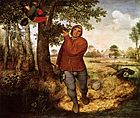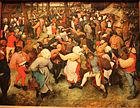- Pieter Bruegel the Elder
-
Pieter Bruegel the Elder 
Bruegel's The Painter and The Connoisseur. drawn c. 1565 is thought to be a self-portrait.Birth name Pieter Bruegel Born c. 1525
Bree, Duchy of Brabant, Habsburg Netherlands (now Belgium)Died 9 September 1569 (age 44)
Brussels, Duchy of Brabant, Habsburg Netherlands (now Belgium)Field Painting, printmaking Movement Dutch and Flemish Renaissance Works Landscape with the Fall of Icarus, The Hunters in the Snow, The Peasant Wedding Pieter Bruegel (Brueghel) the Elder (Dutch pronunciation: [ˈpitəɾ ˈbɾøːɣəl]; c. 1525 – 9 September 1569) was a Flemish renaissance painter and printmaker known for his landscapes and peasant scenes (so called genre painting). He is sometimes referred to as the "Peasant Bruegel" to distinguish him from other members of the Brueghel dynasty, but he is also the one generally meant when the context does not make clear which Brueghel is being referred to. From 1559 he dropped the 'h' from his name and signed his paintings as Bruegel.
Contents
Life
According to some sources he was born in Breugel near the (now Dutch) town of Breda. There are however also records that he was born in Breda, and there is some uncertainty whether the (now Belgian) town of Bree, called Breda in Latin, is meant.[1] He was an apprentice of Pieter Coecke van Aelst, whose daughter Mayken he later married. He spent some time in France and Italy, and then went to Antwerp, where in 1551 he was accepted as a master in the painter's guild. He traveled to Italy soon after, and then returned to Antwerp before settling in Brussels permanently 10 years later.
He received the nickname 'Peasant Bruegel' or 'Bruegel the Peasant' for his alleged practice of dressing up like a peasant in order to mingle at weddings and other celebrations, thereby gaining inspiration and authentic details for his genre paintings. He died in Brussels on 9 September 1569 and was buried in the Kapellekerk. He was the father of Pieter Brueghel the Younger and Jan Brueghel the Elder. Both became painters, but as they were very young children when their father died, it is believed neither received any training from him. According to Carel van Mander, it is likely that they were instructed by their grandmother Mayken Verhulst van Aelst, who was also an artist.
Style
In Bruegel's later years he painted in a simpler style than the Italianate art that prevailed in his time. The most obvious influence on his art is the older Dutch master Hieronymus Bosch, particularly in Bruegel's early "demonological" paintings such as The Triumph of Death and Dulle Griet (Mad Meg). It was in nature, however, that he found his greatest inspiration as he is identified as being a master of landscapes. It was in these landscapes that Bruegel created a story, seeming to combine several scenes in one painting. Such works can be seen in The Fall of the Rebel Angels and the previously mentioned The Triumph of Death.
Themes
Bruegel specialized in genre paintings populated by peasants, often with a large landscape element, but also painted religious works. Making the life and manners of peasants the main focus of a work was rare in painting in Brueghel's time, and he was a pioneer of the Netherlandish genre painting. His earthy, unsentimental but vivid depiction of the rituals of village life—including agriculture, hunts, meals, festivals, dances, and games—are unique windows on a vanished folk culture and a prime source of iconographic evidence about both physical and social aspects of 16th century life. For example, the painting Netherlandish Proverbs illustrates dozens of then-contemporary aphorisms (many of them still in use in current Dutch or Flemish), and Children's Games shows the variety of amusements enjoyed by young people. His winter landscapes of 1565 (e.g. Hunters in the Snow) are taken as corroborative evidence of the severity of winters during the Little Ice Age.
Using abundant spirit and comic power, he created some of the early images of acute social protest in art history. Examples include paintings such as The Fight Between Carnival and Lent (a satire of the conflicts of the Reformation) and engravings like The Ass in the School and Strongboxes Battling Piggybanks. On his deathbed he reportedly ordered his wife to burn the most subversive of his drawings to protect his family from political persecution.[2]
Influence
His painting Landscape with the Fall of Icarus is the subject of the poem "Musée des Beaux Arts" by W.H. Auden, and also of a poem by William Carlos Williams that also uses Bruegel's title.
Russian film director Andrei Tarkovksy referenced Bruegel's paintings in his films several times, notably in Solaris and The Mirror.
His 1564 painting "The Procession to Calvary" inspired a 2011 film, "The Mill and the Cross", in which Bruegel is played by Rutger Hauer.
Works
There are about 45 authenticated surviving paintings, one third of which are in the Kunsthistorisches Museum in Vienna. A number of others are known to have been lost. There are a large number of drawings. Brueghel only etched one plate himself, The Rabbit Hunt, but designed many engravings and etchings, mostly for the Cock publishing house.
-
Landscape with the Fall of Icarus (c. 1558)
-
Netherlandish Proverbs (1559), with peasant scenes illustrating over 100 proverbs
-
The Land of Cockaigne (1567), an illustration of the medieval mythical land of plenty called Cockaigne
-
The Peasant Wedding (1568)
-
The Peasant and the Nest Robber (1568), Kunsthistorisches Museum, Vienna
-
The Harvesters (1565), oil on panel, Metropolitan Museum of Art, New York
-
Massacre of the Innocents, Brukenthal National Museum, Sibiu
-
The Hunters in the Snow (1565), oil on oak panel, Kunsthistorisches Museum, Vienna
-
The Triumph of Death (c. 1562), Museo del Prado, Madrid
- Naval Battle in the Gulf of Naples, 1560, Galleria Doria-Pamphilj, Rome
- The Fall of the Rebel Angels 1562, Royal Museums of Fine Arts of Belgium, Brussels
- The "Little" Tower of Babel, c. 1563, Museum Boymans-van Beuningen, Rotterdam
- The Procession to Calvary, 1564, Kunsthistorisches Museum, Vienna
- The Adoration of the Kings, 1564, The National Gallery, London
- Massacre of the Innocents, c. 1567, versions at Royal Collection, Kunsthistorisches Museum, Vienna, at Brukenthal National Museum, Sibiu,[3] and at Upton House, Banbury
- Royal Museums of Fine Arts of Belgium, Brussels, inv. 8724
- Landscape with Christ and the Apostles at the Sea of Tiberias, 1553, probably with Maarten de Vos, private collection
- Ass at School, 1556, drawing, Print room, Berlin State Museums
- Parable of the Sower, 1557, Timken Museum of Art, San Diego
- Landscape with the Fall of Icarus, c.1554–55, Royal Museums of Fine Arts of Belgium, Brussels – Note: Now seen as a copy of a lost authentic Bruegel painting[4]
- Netherlandish Proverbs, 1559, Gemäldegalerie, Berlin
- The Fight Between Carnival and Lent, 1559, Kunsthistorisches Museum, Vienna
- Portrait of an Old Woman, 1560, Alte Pinakothek, Munich
- Children's Games, 1560, Kunsthistorisches Museum, Vienna
- Temperance, 1560
- Saul (Battle Against The Philistines On The Gilboa), 1562, Kunsthistorisches Museum, Vienna
- Two Small Monkeys, 1562, Staatliche Museen, Gemäldegalerie, Berlin
- The Triumph of Death, c. 1562, Museo del Prado, Madrid
- Dulle Griet (Mad Meg), c. 1562, Museum Mayer van den Bergh, Antwerp
- The Tower of Babel, 1563, Kunsthistorisches Museum, Vienna
- Flight To Egypt, 1563, Courtauld Institute Galleries, London
- The Death of the Virgin, 1564, (grisaille), Upton House, Banbury
- The Months. A cycle of probably 6 paintings of the months or seasons, of which five remain:
- The Hunters in the Snow (Dec.–Jan.), 1565, Kunsthistorisches Museum, Vienna
- The Gloomy Day (Feb.–Mar.), 1565, Kunsthistorisches Museum, Vienna
- The Hay Harvest (June–July), 1565, Lobkowicz Palace at the Prague Castle Complex, Czech Republic
- The Harvesters (Aug.-Sept.), 1565, Metropolitan Museum of Art, New York
- The Return of the Herd (Oct.–Nov.), 1565, Kunsthistorisches Museum, Vienna
- Christ and the Woman Taken in Adultery (1565), Courtauld Institute of Art, London
- The Calumny of Apelles, 1565, drawing, British Museum, London
- The Painter and the Connoisseur, drawing, c. 1565, Albertina, Vienna
- Preaching Of John The Baptist, 1566, Museum of Fine Arts (Budapest)
- Census at Bethlehem, 1566, Royal Museums of Fine Arts of Belgium, Brussels
- The Wedding Dance, c. 1566, Detroit Institute of Arts, Detroit
- Conversion Of Paul, 1567, Kunsthistorishes Museum, Vienna
- The Land of Cockaigne, 1567, Alte Pinakothek, Munich
- The Magpie on the Gallows, 1568, Hessisches Landesmuseum, Darmstadt
- The Misanthrope, 1568, Museo di Capodimonte, Naples
- The Blind Leading the Blind, 1568, Museo Nazionale di Capodimonte, Naples
- The Peasant Wedding, 1568, Kunsthistorisches Museum, Vienna
- The Peasant Dance, 1568, Kunsthistorisches Museum, Vienna
- The Beggars, 1568, Louvre, Paris
- The Peasant and the Nest Robber, 1568, Kunsthistorisches Museum, Vienna
- The Three Soldiers, 1568, The Frick Collection, New York City
- The Storm at Sea, an unfinished work, probably Bruegel's last painting.
- The Wine of Saint Martin’s Day, Museo del Prado, Madrid (discovered in 2010)
Prints
- Large Fish Eat Small Fish, 1556, a print after a Bruegel design
Family tree
Pieter Bruegel the Elder Pieter Brueghel the Younger Jan Brueghel the Elder Ambrosius Brueghel Jan Brueghel the Younger Anna Brueghel David Teniers the Younger Abraham Brueghel Other members of the family include Pieter van Aelst and Mayken Verhulst (father-in-law and mother-in-law to Pieter Bruegel the Elder), Jan van Kessel, senior (grandson of Jan Bruegel the Elder) and Jan van Kessel, junior. Through David Teniers, the family is also related to the whole Teniers family of painters and the Quellinus family of painters and sculptors, since Jan-Erasmus Quellinus married Cornelia, daughter of David Teniers the Younger.
References
- ^ Grove Art Online
- ^ Mayor, A. Hyatt. Prints & People: A Social History of Printed Pictures. Princeton: Princeton University Press, 1971, 426.
- ^ Masterpieces of the Brukenthal Collection
- ^ (Het journaal 1–11/11/09). "deredactie.be". Vrtnieuws.net. http://www.vrtnieuws.net/cm/vrtnieuws.net/cultuurmedia/kunsten/071017Icarus_nietauthentiek. Retrieved 12 November 2009.[dead link]
External links
- Bosch Bruegel Society
- www.Pieter-Bruegel-The-Elder.org 99 works by Pieter Bruegel the Elder
- Complete list of paintings which includes all of the 100 proverbs from the painting, with explanation (in French).
- Timken Museum of Art's "Parable of the Sower" by Pieter Bruegel the Elder
- Creativity Brueghel laid the foundation of the Netherlands School
 "Bruegel". Encyclopedia Americana. 1920.
"Bruegel". Encyclopedia Americana. 1920.
Categories:- Pieter Brueghel the Elder paintings
- Flemish painters
- Landscape artists
- Flemish Renaissance painters
- 1520s births
- 1569 deaths
- People from Breda
- Members of the Antwerp Guild of Saint Luke
-
Wikimedia Foundation. 2010.
















